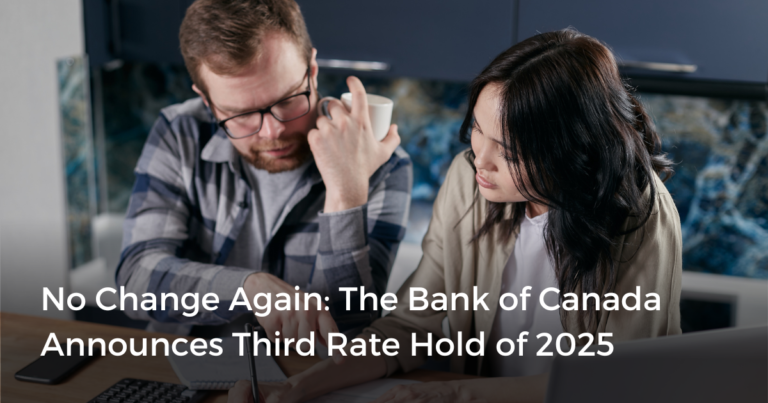In a widely anticipated announcement, the Bank of Canada decided to hold the overnight lending rate at 2.75% today. This marks the third consecutive rate hold of the year, with the BoC last lowering rates in March 2025.
A Reuters poll of economists correctly predicted that today’s announcement would be a rate hold, citing a recent rise in inflation and a fall in unemployment as key reasons. The good news? The same poll also expects two more rate cuts to come later this year.
If Reuters is correct and two more rate cuts are announced in 2025, then the fall real estate market may kick off with a strong improvement in sales.
Momentum is already slowly building for a revival in the real estate market. From February to May 2025, every month showed a national year-over-year sales decline. June 2025 was the first month since January of this year that national home sales showed an improvement, increasing by 3.5%.
June is typically when the busy spring real estate market begins to slow. While many cities followed that trend and saw a month-over-month decline in sales in June, a few stood out with increases. According to the Canadian Real Estate Association (CREA), sales rose by 2.3% in Fraser Valley, 4.0% in Kitchener-Waterloo, 5.0% in Halifax-Dartmouth, and 5.7% in Saskatoon. If the Bank of Canada cuts rates again, we could see sales pick up not just in these cities, but across more regions nationwide.
What’s Holding Buyers Back Currently?
Uncertainty surrounding U.S. tariff threats cast a shadow over nearly all economic activity at the beginning of 2025. Understandably, prospective home buyers felt hesitant about making a big financial decision amid a tumultuous trade war.
The resulting slowdown in sales has led to softening home prices in several markets. As of June 2025, the average home price in Toronto has dropped by 5.2% from 2024, while Vancouver’s average price has decreased by 5.5%. Many buyers are now waiting on the sidelines to see how far prices might fall before making a move.
The fall market could bring the perfect trifecta of conditions to draw buyers off the sidelines. If interest rates drop, prices remain soft, and inventory stays high, this could be the rebound buyers have been waiting for all year.
If you’re one of the 1.2 million Canadians with a mortgage up for renewal this year, you’re likely facing a higher monthly payment than what you locked in back in 2020. According to new data released in July 2025, the Bank of Canada predicts that 60% of those renewing in 2025 and 2026 will see their payments rise.
Most of these borrowers hold five-year, fixed-rate mortgages. However, those with shorter terms may fare better. The BoC estimates that one-quarter of all mortgage holders—many with short-term loans—will actually see their payments decrease by 2026. Meanwhile, just 9% of variable-rate borrowers are expected to face an increase.
It’s important to understand your options if you are renewing this year. According to Ratehub, the lowest variable rate is currently at 3.95% while the lowest fixed rate is 3.89%. It’s a good idea to shop around with multiple lenders to find the best deal. Remember, you’re not obligated to stay with your current lender. Choosing the one with the most competitive rate could save you thousands over the life of your mortgage.
Fixed rates have recently shifted due to changes in the bond market. “ The government of Canada five-year bond yield, which underpins the pricing for five-year fixed mortgage rates, has increased to a six-month high, in the 3% range,” says Penelope Graham, mortgage expert at Ratehub.ca. “This is largely in response to inflation concerns, as both the Canadian and American June prints surprised on the upside. As a result, a number of lenders have increased their fixed mortgage rates, and could be poised to hike them further.”
While fixed rates aren’t directly affected by the Bank of Canada’s decision to hold or cut rates, variable rates are. Choosing a variable-rate mortgage means you could benefit from lower monthly payments if additional rate cuts are announced, but it also comes with risk. Be sure to assess your own risk tolerance before committing.
On the other hand, a fixed-rate mortgage offers stability. With the outcome of U.S. tariffs still uncertain, locking in a rate that won’t change may offer greater peace of mind, especially if you’re a first-time home buyer.
“Fixed mortgage rates are on the rise, variable rates look set for stagnancy, and there are early signs that the housing market is heating back up on a month-over-month basis,” adds Graham. “This means the current affordability conditions enjoyed by buyers are starting to deteriorate. It’s more important than ever to secure a rate hold or full pre-approval when rate shopping to secure access to today’s mortgage pricing.”
Considering a move this year? It doesn’t hurt to start looking. Browse thousands of listings on Zoocasa and explore what’s possible in today’s market.
